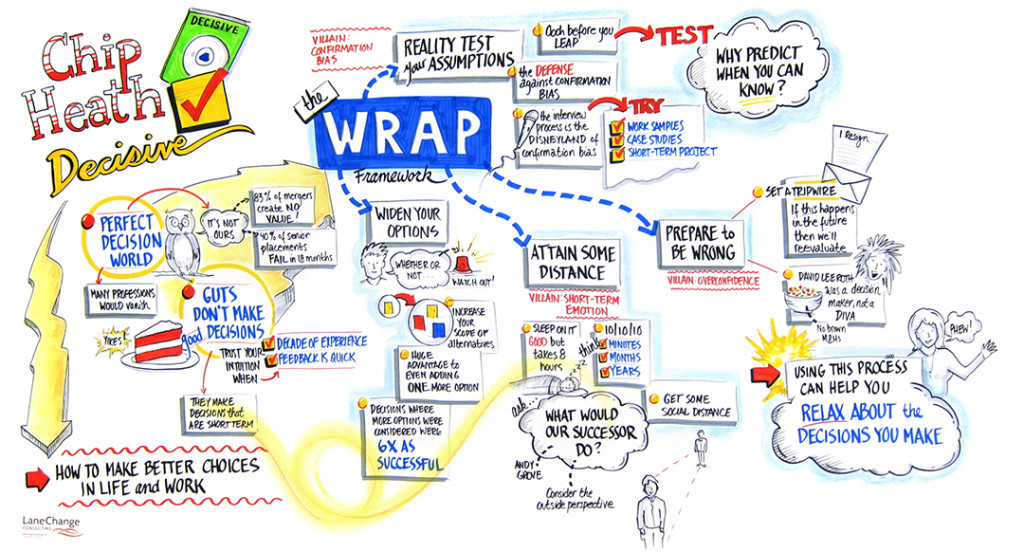
Courtesy of Life Hacker
Decisions, decisions, decisions. If only you can make better ones in the course of your work and life.
Thanks to a recent podcast on Derek Halpern’s Social Triggers Insider featuring Dan Heath, co-author of Decisive, I uncovered a couple of secrets to making good decisions.
Failing to make the right decision can literally cause you your life. Just look at the example of Buridan’s donkey, who was placed between a stack of hay and a pail of water, and couldn’t decide whether to eat or drink first.
Four Villains of Decision Making
Before we go into that, it is useful first to learn about the four “villains” of decision making. Like the proverbial four horsemen, Heath outlined that these common emotional and psychological traps and biases are:
#1 Neuroframing
Neuroframing is our tendency to unduly limit our choices when we make decisions to an either-or scenario. In other words, we fail to consider other possibilities outside our frame of reference.
#2 Confirmation Bias
Confirmation bias is our inclination to seek information that flatters our belief. At the same time, we avoid those which may make us feel uncomfortable or conflicted.
#3 Short-term Emotion
These are the negative influences of short-term stresses and emotions in decision making. Remember the saying that we should never make any decision in a huff?
#4 Overconfidence
Overconfidence isn’t quite the same as cockiness, which is a boastful swaggering behaviour. Rather, it is our perception that we know more than what we really we do of how the future will unfold.
Let us now go into how we can resolve each of these conundrums.
Reframing Our Situation
Now neuroframing frequently occurs whenever we ask ourselves “whether or not” questions. This phenomenon is frequently seen amongst teenagers who ask themselves whether or not they should go to a party, disregarding other permutations.
Surprisingly, many managers also fall prey to the same conundrum. In fact, we only spend 29% of our time considering decisions with more than one outcome.
From “whether or not” to “this and that”
The trick here is to reframe our situation such that it doesn’t have to be an all or nothing scenario.
Instead of asking ourselves whether we should quit from our job (or not), we could consider other options like seeking a transfer or downsizing our responsibilities so that we have more time to sample other alternatives.
In other words, we should start asking ourselves a “this and that” question. Thus, we can have our cake and eat it too!
The Science of Ooching
Rather than plunge into the unknown, Heath proposed that we embrace a process known as “ooching”. To “ooch” is to construct small experiments to test one’s hypothesis.
For workers, this could mean staying in your job while dabbling in something first before quitting.
Considering Opportunity Costs
To break out of your narrow frames, you should also consider the opportunity costs of a decision. For example, when making a purchase, you can ask yourself what’s the next best thing you can do with the money. Often, this involves skipping across different domains.
For instance, should you invest $1,000 in a brand new TV? Go on a short vacation? Or take up a Korean language class? In other words, consider what you are giving up and what you can do with the extra time or money that an alternative decision provides.
In one example, Heath cited that including the statement “Buy the video or keep the $14.99 for other purchases” in the decision matrix of consumers led to a drop in potential buyers from 75% to 50%. I guess this is a good way to curb impulse purchases!
Eliminating Confirmation Bias
Confirmation bias, considered the “nastiest villain” in the decision process, is our desire to want something to be true so much so that we only look for positive information reinforcing that notion. Often, such biasness is the Achilles heel of entrepreneurs who persist in looking at the world through rose-tinted lenses despite evidence that indicates otherwise.
By making it exceedingly difficult to consider the ugly truth, confirmation bias makes us imagine that the positive feedback we receive during meetings are truthful and honest. We also tend to cherry pick evidence that supports what we want.
Unfortunately, this often isn’t the case.
Quoting a friend, Heath shared that “no one in life is going to tell you your baby is ugly.” Indeed, most people have nothing to gain from telling us the bad news. Doing so may result in fierce resistance, arguments and conflicts – none of which are desirable in any relationship.
To overcome this blind spot, consider polling strangers. Solicit their honest and unfiltered opinions. Look for opportunities to include neutral and disconfirming information, and venture beyond your inner circle to “look for answers in the world that are rarely in our heads”.
Transcending Short-term Emotions
Short term emotions are seen in situations where we become too emotionally connected to the decision and struggle with being appropriately detached.
According to this blogpost:
“When people share the worst decisions they’ve made in life, they are often recalling choices made in the grip of visceral emotion: anger, lust, anxiety, greed.”
To escape the tyranny of stressful emotions, one could adopt the 10|10|10 strategy proposed by the Heath brothers, ie “How will I feel ten minutes after making this decision? In ten months? Or ten years?”
Doing so allows us to distance ourselves from the overwhelming feelings which envelop us in the throes of stressful situations.
Overcoming Overconfidence
Overconfidence, the final psychological trap, is a phenomena which makes us consider a decision as a finale or period, ie the end of something.
In reality, though, decisions are more like hypotheses than conclusions. They are a lot more nuanced, and function like commas that transit from one point to another.
Instead of considering our decisions as “be all and end alls”, Heath advises us to use a tripwire to move from one decision to the next. A tripwire is a pivotal question or acid test. It provides a concrete metric to signal when we should change course.
Perils of Excess Focus
In the podcast, we’re also warned about the perils of excess focus. Citing the classic example of the invisible gorilla study, Heath proposes that focus can be the enemy of expanding our options in a positive way.
The WRAP Framework of Decision Making
How then can one make better decisions? Heath proposes the WRAP framework, namely:
- Widening your options so that you can minimise neuroframing;
- Reality testing your assumptions by fighting confirmation bias;
- Attaining distance before making a decision. This involves stepping back from the stresses, emotions and pressures of making a decision; and
- Preparing to be wrong. Stop thinking of decisions as permanent indelible actions. Rather, consider them as provisional steps.
Check out the wonderful sketch bellow illustrating how this can be considered.
Courtesy of Lane Change Consulting
To put WRAP in practice, Heath suggests that we can develop a playlist – a list of provocative questions and thoughts that can be consulted again and again. This tool should be used to help debunk and overcome the decision biases that assail us.
We should also embrace probing rather than open ended questions.
For example, if we’re law students seeking opportunities for internship, we shouldn’t just ask general questions like “Hey, do you guys have a life here?”
Instead, we could ask very specific questions that are probing and data gathering. Questions like “How many associates are there in this firm?”, “When are they hired?”, “Which areas of practice do you specialise in?” and “Can I speak to them in detail?”
Looks like Decisive is going to be another great read by the Heath brothers. I’m certainly going to pick a copy up when it’s available here.
Do also check out Derek Halpern’s Social Trigger Insider for more amazing insights in consumer behaviour and psychology.


I have read your blog post on “How to Make Better Decisions” related information and found your nice blog site. so thank you very much for sharing this valuable contents. I will visit again to read more post. 🙂
Very useful and effective post . Always i’m searching such educative post . Thanks for shared .